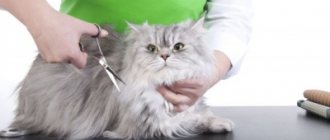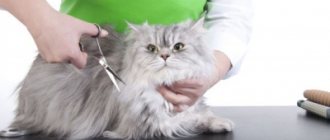Reasons for euthanasia
Don’t think that putting a suffering animal to sleep is a crime. No more humane methods of helping hopeless patients have been invented. There are several basic reasons why doctors decide to euthanize a cat.
Euthanasia of a cat
Rabies
A dangerous viral pathology that threatens the life of not only the animal, but also its owner.
It is impossible to cure rabies - after pathogens enter the bloodstream, they quickly multiply, the pet loses clarity of consciousness and begins to attack people close to it. If the bite is successful, the owner will face the same fate: a long and painful death from dehydration and damage to the nervous system.
Important! When a diagnosis of rabies is made, the domestic cat must be euthanized. The veterinary hospital does not provide treatment due to the high risk of infection of medical personnel.
Oncology
Malignant neoplasms quickly increase in size, gradually spreading throughout the body through metastasis. Advanced forms of therapy are not subject to treatment - in other cases, the cat is prescribed surgical excision of the tumor.
For older cats or those with terminal cancer, euthanasia is recommended. Attempts to cure a pet are useless - veterinarians do not advise prolonging the death throes of a furry pet.
Important! An animal can be euthanized only with the consent of the owner - the veterinary hospital does not have the right to carry out the procedure without filling out the appropriate documents.
Injuries incompatible with life
Complex fractures and ruptures of internal organs are almost impossible to restore. For some time, observation tactics are established for the furry patient - some animals manage to survive even after being hit by a heavy truck.
If no improvement is observed, the veterinarian issues a conclusion that the injuries caused by a fall or collision are incompatible with life. Medical killing is the best way to stop the prolonged agony and stop tormenting your pet.
Making a final diagnosis
Respiratory failure
The pathological condition is divided into four large subgroups:
- Hyperventilation of the lungs or general disturbance of the breathing process. The problem is caused by traumatic brain injuries, hydrothorax (fluid accumulation in the lungs), and strong blows to the chest area. As a result, the cat practically cannot breathe and suffers from pain.
- Trauma and impaired functionality of the lungs themselves are associated with tissue swelling, bronchospasms, and an advanced form of pneumonia (pneumonia).
- Parasitic damage - inflammatory processes in the lung tissues are provoked by the migration of roundworm larvae from the area of the digestive tract.
- Malignant and benign tumors are typical for older cats.
The above pathologies lead to the development of respiratory failure. The animal gradually dies from lack of oxygen and necrosis (death) of brain tissue.
Incurable disease
Diseases that cannot be treated or treated surgically also include:
- stopping the functioning of the digestive and urinary system;
- leptospirosis and infectious peritonitis (inflammation of the abdominal cavity with suppuration);
- inflammatory processes in the spinal cord or its ruptures - as a consequence of previously developed renal failure.
How to stop breastfeeding?
How to properly end breastfeeding? Let's try to answer this question. WHO recommends that breastfeeding be continued until the child is 2 years old, or longer as the mother or baby wishes.
We do not recommend
Option to “leave for a while”
You may be familiar with the advice to “leave your baby for a couple of days and rest” to ease the process of finishing breastfeeding. They refer to the fact that the child will “forget” during this time, and it will be easier to wean him off the breast. Why this might not be the best solution:
- the likelihood of lactostasis (stagnation of milk in the breast) and even mastitis (inflammation of the mammary glands, which may require surgical treatment) increases;
- For a child at that age, the disappearance of his mother means strong emotions. The baby still cannot realize that his mother will soon return to him;
- An abrupt cessation of feeding is a serious stress for a child, which can provoke anxiety, nervousness and corresponding changes in behavior.
What else should you not do?
- take hormonal medications recommended to complete lactation, since this is not effective (milk production largely depends on the frequency of breast emptying);
- Tightening and squeezing the breasts, which can cause lactostasis and mastitis;
- use herbal and homeopathic remedies whose effectiveness has not been proven;
- Reduce your fluid intake as this will not affect milk production but will make you dehydrated.
Recommended Steps
Now let's move on to more humane methods. The most effective and safest method of ending feeding is a smooth and gradual reduction in feedings. You can:
- “not to offer, but not to refuse”;
- talk to your child about this in advance;
- distract the baby from situations where he may want to breastfeed;
- enlist the support of relatives;
- feed only in a certain place;
- wear closed clothes;
- separate breastfeeding and sleep, if this has not happened before;
- It is allowed to express milk a little if the breast feels full, you can apply cold;
- remove one feeding every 1-2 weeks, starting with those that the baby needs least.
There is also the possibility that the baby will outgrow the need for the breast and finish breastfeeding himself!
Take your time, act carefully and gradually, with respect for the baby’s needs, then the process of completing breastfeeding will be as comfortable and painless as possible.
Methods of painless euthanasia
How to brush a cat's teeth: options at home
The method refers to irreversible processes, with the deliberate deprivation of the life of an animal under constant control. During the manipulations, dysfunction of the nervous, cardiac, and pulmonary systems gradually occurs.
Important! The technique is intended to stop the torment of a hopelessly ill organism - for good. For the animal it is painless.
How do they euthanize sick cats in veterinary clinics? Regardless of the location, the process takes place in several steps:
- The pet owner signs all necessary documents confirming his consent to the procedure. The decision is made voluntarily; no one can force the owner of a sick animal to agree to the operation. The veterinarian's opinion does not matter.
- The cat is given a sleeping pill or painkiller, with which it falls asleep and completely loses sensitivity. If such a clause is not stipulated in the contract of a pet clinic or field specialist, then it means they are working on scammers.
- Muscle relaxants are administered after confirmation of the transition to the deep phase of sleep - the pet does not feel anything and does not react to external stimuli. The result of their action will be a gradual slowdown in muscle activity, stopping the work of the heart muscle and stopping breathing.
- The heart is listened to; if there are no contractions, death is declared.
Medicines
The owner can be with the cat being euthanized at all times or refuse to attend the procedure. Before carrying out the manipulations, the veterinarian describes in detail all phases, focusing on key points. Doctors advise standing near the pet only during the introduction of anesthesia, and then leaving the manipulation room. After the administration of muscle relaxants, convulsions occur, which are perceived as a painful reaction to the injection.
Sedatives
Veterinary clinics can use:
- Xylazine hydrochloride;
- Xila;
- Xylanite;
- Rometar.
Important! The drugs are analogous in their spectrum of action and are used in veterinary medicine for a sedative effect. In large dosages, the drugs provoke respiratory arrest.
Anesthetics
Painkillers include:
- Pentobarbital sodium;
- Sodium etaminal;
- Sodium thiopental;
- Propofol;
- Droperidol;
- Zolazepam.
Medicines are responsible for suppressing the central nervous system, placing the patient under deep anesthesia, and can provoke a stop in the functioning of the respiratory center.
Muscle relaxants
Block neuromuscular conduction. When euthanasia can be used:
- Ardoin;
- Aperomide;
- Vero-Pipecuronium.
Antiarrhythmic
In veterinary medicine they use:
- Lidocaine;
- Versatis;
- Xylocaine;
- Helicain.
Large dosages cause cardiac arrest due to the cardiotoxic effect.
Important! It will not be possible to legally kill a healthy cat - not a single station will undertake the procedure without reason.
When contacting dubious specialists, you can expect painful and long agony for a dying animal - most of them break the rules and administer muscle relaxants without anesthesia, leaving the pet to suffocate in full consciousness.
“You can and should cry.” How to cope with the death of a pet
When a person loses loved ones, those around him try in every possible way to help him. But if we are talking about the death of a cat or dog, such attentive attention may not be expected, although the suffering from the loss of a pet can also be severe and even lead to depression. Psychologist Maria Merkulova tells how to survive this grief .
Natalya Kozhina, AiF. ru : Maria, some people get over the loss of a pet quite quickly, but there are those who suffer greatly and even turn to psychologists for help, why does this happen?
Maria Merkulova: It’s simple - on average, pets, for example, dogs and cats, live 10-15 years. This is a long period of time during which they become practically family members. It would be strange not to experience their departure in any way and remain completely indifferent.
The death of a pet can be compared to the loss of a loved one. Moreover, sometimes (usually this happens in children) this is a greater loss than the departure of a grandmother or grandfather who did not live nearby. This should not surprise parents, since the child could see his beloved dog more often than his relatives, communicated with it every day, and had an emotional attachment to the animal.
Article on the topic
Just a toy or a full-fledged family member? Why does a child need a pet?
— If you compare the loss of a pet with the loss of a loved one, the owner of the animal will experience his grief in certain phases, right?
- Yes, the phases will be the same as when you lose a loved one. First there is a shock, an acute reaction, when a person cries or may even become hysterical. To help alleviate this, it is recommended that you talk about your grief with someone you trust in the very first hours and days after the tragedy. If you are not ready for such a dialogue, simply remain silent with the person, holding hands or hugging.
Next comes the reflection phase. The question arises: “Why did this happen to me?” It usually takes the longest. And the last phase is accepting the situation, coming to terms with it. Absolutely all people go through this, because this is how our psyche works.
It is important not to get stuck in each of these periods, and this happens sometimes. If a year has passed since the tragedy, and you still cannot come to terms with the loss, you should contact a specialist. When experiences drag on for two years or more, it can be dangerous to health. Sometimes people enjoy their grief and immerse themselves in it, which is bad.
If you immediately react to grief, it goes away much faster than if you try to drown it out in every possible way. Give yourself the opportunity and time to be sad.
— Maria Merkulova
“But the opposite situation can also happen, when a person literally returns to normal in a matter of days and pretends that nothing bad happened. It seems to me that such behavior does not promise anything good either?
“When a person pretends that nothing terrible has happened, throws himself into work or school, suddenly begins to lead a more active social life, and at the same time he himself is very worried - this is a time bomb. There is a high probability that it will explode someday. If you immediately react to grief, it will go away much faster than if you try to drown it out in every possible way. Give yourself the opportunity and time to be sad and accept the loss.
In general, in such a situation you need to be especially attentive to yourself. If you want to communicate with people, of course, communicate, but if you want to be alone, you don’t have to force yourself and drag yourself to some party on purpose.
The most toxic phrase: “Everything will be fine.” Believe me, it has the absolutely opposite effect on someone who is in grief - it does not calm, but irritates and even causes aggression.
— Maria Merkulova
— What phrases should not be said to a person who has experienced the death of a pet?
— Perhaps the most toxic phrase: “Everything will be fine.” Believe me, it has the absolutely opposite effect on someone who is in grief - it does not calm, but irritates and even causes aggression.
Never say, “It’s just an animal.” Don't discount someone else's feelings. For some, a pet is a companion and a loyal friend.
Another mistake is to use the phrases “nothing lasts forever” or “if you’re suffering so much, let’s never have anyone again.” Your primary task is to respect the feelings of a person in grief and, if possible, provide him with support, and not finish him off with your words.
“He was the one who saved me.” Dogs that changed the lives of their owners Read more
— People often try to drown out their grief by getting a new pet. This can help?
- There is no need to rush. Again, give yourself time to grieve and yearn for the loved one you have lost. This may take several months or even a year, which is absolutely normal.
— What to do in a situation where a person had to euthanize a pet? This can lead to strong feelings of guilt.
- Let's immediately clarify one important point: if there is a need to euthanize a pet because it is suffering, in no case should you ask the child for advice on this topic. Don't shift responsibility onto him. The decision must be made by an adult. But, of course, you are obliged to inform your child.
If there are no children, and such a choice is before you, perhaps the only person with whom it makes sense to somehow consult is a veterinarian. He is the one who can say exactly how long the pet will live and how much he suffers from his illness.
As for the feeling of guilt, it usually arises when there is no confidence in the correctness of the chosen decision, i.e. you doubt that putting your pet to sleep is really a necessary measure. Any doubts? Then it is better to postpone this issue and continue caring for the animal.
Article on the topic
Dog handler Grigory Manev: “Dogs are nobler and fairer than people”
— But if a person has already euthanized an animal and there is a feeling of guilt, how to work with him?
— A feeling of guilt appears and prevents us from living if you haven’t done something for your pet even before euthanasia, for example, you paid little attention to him or didn’t walk him enough, you went to the doctor late, etc. It makes sense to work through this moment. Ask yourself a question: in reality, in the conditions in which you lived, could you change the situation? Most likely no. For example, it is objectively difficult for a working person to walk his dog four times a day - to make this possible, he would have to quit his job.
Honest answers to the questions posed will gradually reduce the feeling of guilt to nothing. But I would recommend asking them not alone, but, say, in the company of a loved one who will help you look at the situation more objectively.
— You said that in the matter of euthanizing a pet or a child, in fact, you just need to confront the fact, and not ask his advice on the topic of whether or not to euthanize. Won't this make it worse?
— You just need to act delicately and competently from the beginning: tell us how you will take the animal to the hospital, how the doctor will give an injection, and your pet will stop suffering and fall asleep forever.
If you do not inform the child and not only the child, even an adult, for example, your husband or wife, and the person finds out about everything after the fact, he may accuse you of “killing” the animal.
Article on the topic
“Mom, are we going to die?” How to talk to kids about death
— When a pet dies, what is the best way to present this information to the child?
- Use simple and understandable words in your speech: “Our dog died.” Of course, the child may ask: “How did this happen?” With kids, do not go into sad details, especially if there was an accident. Those who are older can be told more details and even bury the pet together. When an animal does not die a natural death or is disfigured, it is better to wrap its body in something so as not to further traumatize the child’s psyche.
It can be very difficult for children when their close friend - a dog, cat, hamster, etc. - dies. On the other hand, such experience is also important and can be useful, because using the example of an animal we can explain to a child what death is. This is a reason to talk about this topic: “Why are we not eternal? What happens after death? Etc. Of course, there is no clear position here, but every parent can answer such questions from the point of view of their faith and the concept of life that they adhere to.
The experience of losing an animal helps the child to consolidate at the mental level the idea that death can be survived. Yes, it hurts, but you need to find the strength to live on. And in the future, when he faces death as an adult, it will be easier for him to accept it and cope with stress.
— How to carry out a ritual of farewell to an animal?
“There are no clear instructions here; you can bury your pet or scatter its ashes. Take the action that will help you say goodbye to your dear friend and let him go.
Crying is one of the most effective responses to stress. Of course, it’s better not to fall into hysterics, because it destroys and exhausts, but crying is welcome.
— Maria Merkulova
— When a person is in grief, experiencing the loss of a pet, he may receive questions from others: “What’s wrong with you?” How to answer them, and is some kind of answer always necessary?
— Such questions are quite natural: when others see that your condition and behavior have changed, they want to know the reason. Sometimes out of curiosity, sometimes they are driven by a feeling of caring for you.
It also happens that people know about your trouble, but have no idea how to behave in this situation. When deciding what is appropriate and what is not, they rely primarily on their own experience. You don’t have to adapt to someone; it’s important to hear yourself and your needs first. If you want to share your grief, please share. You can cry. This is one of the most effective responses to stress. Of course, it’s better not to fall into hysterics, because it destroys and exhausts, but crying is welcome. If you feel tightness, resistance, you are irritated by the questions of others, in principle, you can not answer anything at all or say: “I don’t want to talk,” “I’m not having the best times right now.” There is no need to squeeze anything out of yourself. In this way, you only make things worse, and at the moment of loss, it is very important for a person to conserve strength in order to help himself return to his normal life.
Euthanasia at home
DIY cat scratching post: options at home
Some owners believe that it is better to carry out the procedure at home so that the animal is less nervous. Almost all veterinary stations provide such services, with a specialist visiting on the agreed day.
The doctor will first get acquainted with the cat's medical history and only then begin to euthanize. The presence of the owner in the room is not necessary - only at his personal request.
Examination by a veterinarian at home
Important! The main problem with the home procedure is the question of the body of the deceased - in the hospital the owner will be offered cremation. Before calling a veterinarian, you can ask whether he provides additional services with the collection of a deceased cat.
Options for putting a cat to sleep temporarily
Euthanasia refers to a reversible process, as a result of which the pet falls asleep under the influence of medications, and not on its own. All of them affect certain parts of the brain.
How to worm a cat at home
How to put a cat to sleep? Temporary induction of sleep is carried out using:
- Droperidol is a neuroleptic drug from the butyrophenone subgroup, with a sedative and tranquilizing spectrum of action. The drug stops motor activity, relaxes muscles, and is often used in premedication.
- Proforol - a general analgesic effect is achieved by depression of the central nervous system and is produced in the form of an emulsion.
- Proforol is a muscle relaxant classified as a curare-like substance.
- Ditilina - relaxes muscle tissue, slows down the heartbeat and heart function.
- Thiopental - causes a state resembling deep anesthesia.
- Dimetrol - with a hypnotic effect due to central nervous system depression.
- Zolarepam is a pain reliever.
The listed medications are not a complete list of medications used in animal hospitals. Most of them cannot be purchased at a pharmacy without a doctor's prescription.
Important! Sleeping pills for cats cannot be used at will. Incorrect dosage selection will cause serious poisoning, and in difficult cases, death.
Sleeping pill for hair cutting
Before a long trip, moving, getting a haircut or visiting a veterinarian, you can use mild sedatives or homeopathic medications. They are prescribed by a doctor when participating in cat shows or when adding a second animal to the house. Popular sleeping aids for cats for transport that allow them to be easily trimmed include:
Kot Bayun - sleeping pills for cats
- Kot Bayun - produced in tablets and tincture, intended for oral administration. It contains medicinal plants and has a moderate sedative effect.
- Stop Stress - relieves the effects of nervous overload, calms. The mild effect is due to the component composition: mint, motherwort, hops.
- Fitex - calms, normalizes sleep, improves the condition of the nervous system. Made in drops, it contains valerian, motherwort and hops.
Important! Herbal medicines are the best option for a nervous kitten who hasn’t slept for days. They are not addictive with prolonged use.
Cost of euthanasia in a veterinary clinic
How much does it cost to euthanize a sick cat? Price depends:
- depending on the regional location of the clinic - in small towns the cost is lower than in big cities;
- veterinary hospital level;
- pet's body weight;
- additional services - travel to home conditions, subsequent cremation.
The average price varies from 500 to 5000 rubles; in Moscow, the average cost of the procedure is about 2750 rubles. A doctor’s visit to your home will increase the total cost by 1000-1500 rubles, cremation will add 500 or more rubles.
Euthanasia of an incurable cat is not murder, but an opportunity for the animal to stop suffering. The procedure will stop the suffering of the animal and its owner - the latter will not worry about his own helplessness.
Criminal liability for killing an animal
Criminal liability for cruelty to animals comes under Article 245 of the Criminal Code of the Russian Federation dated June 13, 1996 No. 63-FZ (as amended on December 27, 2018) “Cruelty to animals.” For criminal liability it is necessary - cruelty to animals, resulting in their death or injury, for the purposes of:
- causing suffering and pain;
- for hooligan reasons;
- for selfish reasons.
The court does not distinguish consequences for objects of the animal world according to severity. Equal criminal penalties are applied for both killing an animal and mutilating it.
The subject of this crime is animals - wild, domestic, any. The necessary sign is the occurrence of death or injury. Abuse can be expressed:
- In actions:
- beating;
- use for competitions;
- sale for fights and bleeding;
- sacrifice according to cult rites;
- conducting experiments;
- cutting off limbs;
- burning;
- hunting in inhumane ways and others.
- Inactive:
- deprivation of food and drink;
- intentionally leaving others in a life-threatening situation.
Organizers of dog, cock and any other fights also face criminal penalties under Article 245 of the Criminal Code of the Russian Federation. In practice, this is quite difficult to prove.
Criminal liability is brought only if the person who committed the crime has reached 16 years of age and is sane - understands what he is doing and what consequences are possible.
Teenagers under 16 years of age are also punished, but in a different way - they are registered with the commission for minors. The commission decides what to do with the juvenile offender:
- apply educational measures, conduct an explanatory conversation;
- transfer the case to the court to send the teenager to a closed educational institution.
Part 1 art. 245 of the Criminal Code of the Russian Federation
Punishment under Part 1 of Article 245 is possible as follows:
- A fine of up to 80 thousand rubles (or a deduction of 6 months’ income).
- Up to 15 days of compulsory work.
- Correctional labor or restriction of freedom for up to 12 months.
- Arrest for up to six months.
- Imprisonment up to 3 years.











